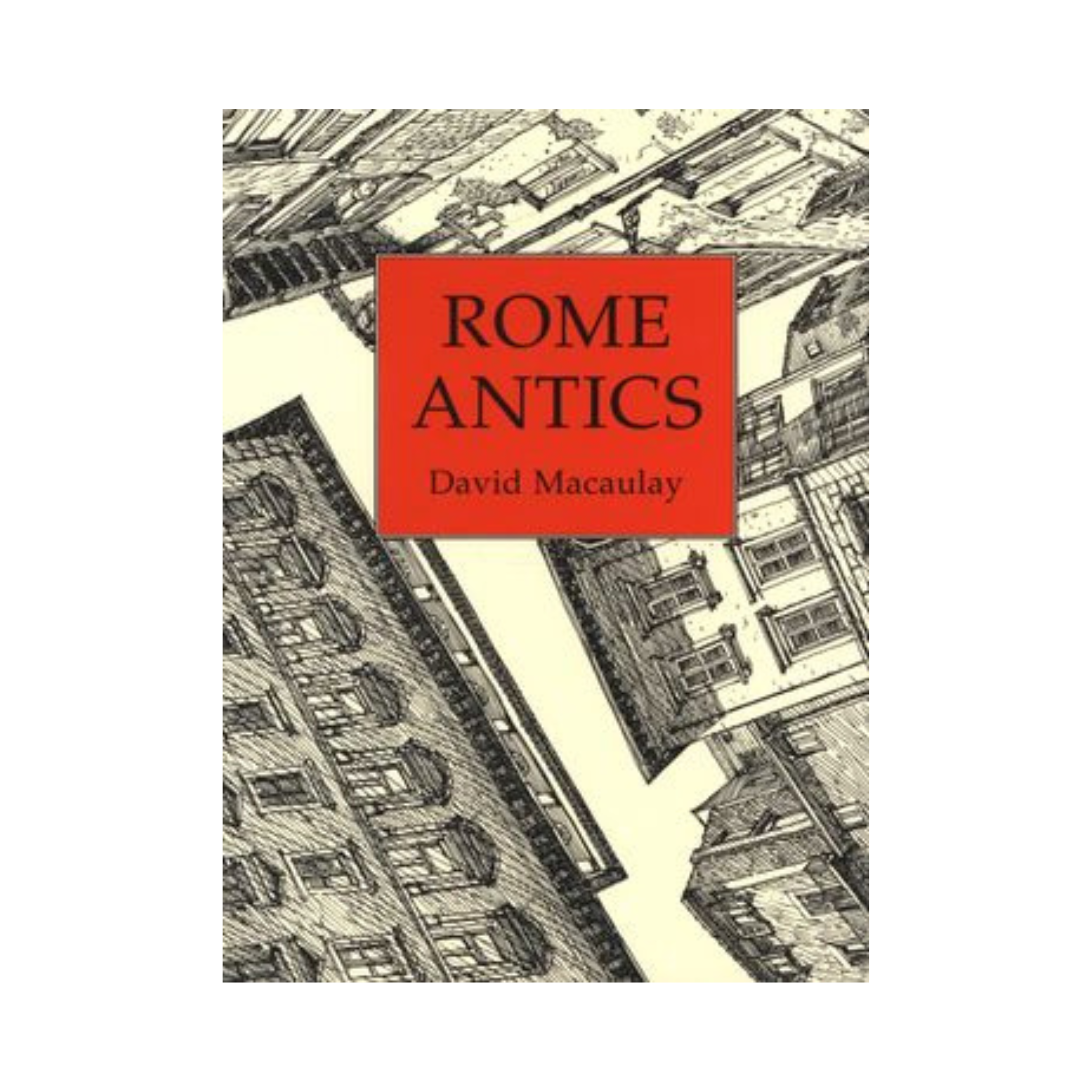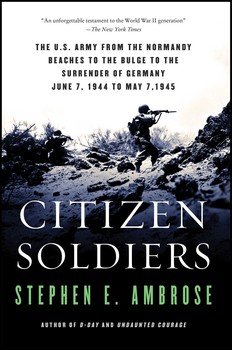
Written in the late 1990’s, Stephen Ambrose’s “Citizen Soldiers” draws upon oral histories, memoirs, and letters of Allied and German World War II combat veterans to write an engaging narrative that follows U.S. combat soldiers from the D-Day landings at Normandy to the surrender of Germany in 1945, inviting the reader to join his harrowing and inspirational account of the final eleven months of the war. Best known for his book-turned-TV-miniseries, “Band of Brothers”, Ambrose writes in a straightforward and readable manner, accessible to all who are interested in history and the strength of human character found in the common and everyday citizens who enlisted and were drafted into war. Following the timeline from the day after D-Day, the book includes three sections of contemporary black and white photographs that follow the chronological order of the chapters. Other features of the book include detailed maps showing battlefronts and army progress, meticulous footnotes from each chapter, an exhaustive bibliography, a comprehensive index, and a complete list of the full names of U.S. and German veterans whose letters, memoirs and oral histories were used in the crafting of this account. While the content is serious, mature grade 11 and 12 students can handle the material, and while the language used by soldiers in war can be punctuated with cursing, the direct quotes of combat veterans included by the author are never used in a gratuitous or entertaining manner. Please note that there is a brief reference to how leadership in different armies would respond to reports of soldiers assaulting local women (Russian and German Army leadership encouraged it, US Army court-martialled and sometimes executed offenders from its own ranks). This book can accompany and complement a homeschool curriculum of 20th Century World History. At just under 500 pages, a student, with regular reading, will be able to fully understand the material, enabling them to speak with intelligence on an important event from our recent past. Students can use the strategic maps to further explore the geography of the surrounding areas in Europe. Most importantly, young people reading a first-hand account can be shown extraordinary examples of character. Finding ways for older students to demonstrate their understanding through essays, paragraphs, creative writing, artwork, discussions and dioramas will not be difficult, as there are many topics that can be gleaned from the material. Citizen Soldiers is an excellent account of a very specific time period of a war in which common men and women displayed uncommon bravery not to conquer but to liberate. Jeffrey Curwen, BA, Certificate in Liberal Arts, Professional Teaching Certificate, M.Ed Jeff is a Canadian homeschool dad of seven kids, and husband to one amazing woman. He has worked as a public school teacher, independent DL school teacher, and secondary school administrator. He enjoys coffee, jazz and almost anything written on 20th Century History, US Foreign Policy and JFK. He’s grateful everyday for his wife, children and his Lord and Saviour, Jesus.

Homeschool Science: The Story of Science: Aristotle Leads the Way Aristotle Leads the Way was the main science text I found to pair with Beautiful Feet Books Ancient History (Intermediate) curriculum for my past year of homeschooling. My kids were in grades 6 and 8 this past year, and we often do Socials and Science together for ease. Aristotle Leads the Way was a perfect fit for middle school. I wanted an open-and-go resource that we would be able to keep up with our interwoven subjects. I was so pleased with this choice! It created a rich and fertile ground for seeping ourselves into history I’d forgotten from my youth but was eager to press into.* Teach Science through History Finding Aristotle Leads the Way was like finding a needle in a haystack. I was able to marry two sciences that my children enjoy learning about–Physics and Astronomy–with the historical era of Ancient Egypt, Greece, and Rome. If your child has never been introduced to either of these subjects, it doesn’t matter. This is an excellent place to start because Hakim gives us the chronological order of the ideas and observations that birthed these two subjects. If your students have had experience they’ll find new information and rediscover the why and how behind these disciplines from great thinkers of ancient times. As far as textbooks go, this is a smaller one, but at just under 300 pages, it’s flush with ancient maps, geographical photographs to provide context, works of art throughout antiquity, diagrams of inventions, and little excerpts that give the student practice with the concepts, whether that’s prime numbers or how Hero calculated the area of a triangle. Don’t know who Hero was? You’ll want to look him up; he was one of my students’ favorite thinkers and tinkerers from this text. If Hero’s ideas would have caught on quicker we’d likely be in flying cars by now! He invented hydraulics and a steam-powered device while living in Alexandria. The steam-engine powered train was up and running only 18 centuries later. Hero was a tad ahead of his time. I learned a lot this past year alongside my kids, and Hakim was a fantastic tour guide. She has a witty sense of humor, and the book is written to be read as a story. She spins the known world and highlights the masters of antiquity in philosophy, astronomy, physics, engineering, and mathematics, and how all of these disciplines were entwined together in the beginnings of scientific thought, experimentation, and record. We had such a good experience with Aristotle Leads the Way that we’ll be finishing the series over the next two years, adding Newton at the Center and Einstein Adds a Dimension, to our curriculum choices for science. I don’t recall ever hearing a peer saying to another, “Wow, that was really good!” about a textbook but that happened in my classroom! *So many puns, so little time. My name is Sarah Mast and I homeschool my two kids in Ft. Langley, BC. One of my favorite aspects of homeschooling is the community gained, and I volunteer with a local support group to help foster that and connect others. My family loves the outdoors and traveling, and our weekends include skiing, swimming, hiking, or biking depending on the season. I found Classical Education Books at a conference and noticed their well-curated selection of children’s books. I kept tabs on their collection of the classics and hard-to-find books and reached out. Now I get to help customers hone their collections, and work on the ever-growing inventory here at CEB!

Classical education is a new term for an old path. Over the last several years it is being rediscovered. It’s the classic path, the path that was well travelled but somehow our adventurous natures took us beyond that path. As we try to rediscover how our Western Culture gave us a richness of beauty, truth and goodness that we have not been able to replicate in recent years, it turns out we’re in for a bit of a journey. This journey is presented in many different ways, styles and methods. Classical Education: Way Back When I’d like to take you back to a time before the phrase “classical education” emerged. Way back to the time when communication between human beings was primarily oral, or speaking. Some people were beginning to create systems of writing where words could be put down in a concrete, tangible ways. But it was not easy to do, so only the most important, or valued words were set down in a way that could exist outside of the human mind. Many of the texts that we have from that beginning are a good source for us to learn about who we are as human beings, but also how human beings have behaved and how or if that has changed. We need to pay special attention to some of the civilizations that existed before the birth of Christ such as the Greek, Roman, and Jewish cultures. These are three cultures whose words were put in written form and passed through the ages. When we take a closer look we will see that, as some of the first recorded thinkers, they presented foundational truths that have been built upon. To be fair, it’s not easy to take a few thousand years of history and boil it down to into a neat little summary. However, like a valiant student of the subject who can’t always distinguish between brash and brave, I’ll delve in with you and take to heart what G.K. Chesterton said: “If a thing is worth doing, it’s worth doing badly.” And I believe so strongly that it’s worth learning about our past because I believe that there is no other way to change our future. So let’s give this a try. Some Truth and Good Ideas The Greek civilization was keen to look at man as more than a physical phenomenon. Through the works of Plato we learn that man is more than a body; more than what is visible to the eye. Plato tells us about another part of man which we know to be the soul. He goes on, at tedious length I might add, to discuss what that means, and how a man can take control of his actions and become self-governed. He explains to us that to become more human, man must learn to conduct himself in a way that benefits the greater good, and the wider community of mankind. While all these ideas resonate with us, we feel something lacking. That’s because there was a major piece missing in Greek thought which became evident when, despite their efforts to be man in perfection, they were invaded by a barbarian horde who became their rulers. Some of the barbarian hordes listened to the ideas that the Greeks had put forward, and these ideas resonated with them too. As a result, they tamed their wild natures to be able to get along for the greater good of the community, or you could say they learned to be civil. And thus, we come to one of history’s greatest civilizations, the Roman Empire. The Greek ideas became the teachers in this new order, and the idea of a self-governed man became alive as the civilization began to set up structures to rule over other people. The self-governed man was learning to rule as a governor of many men, but also how to live under a governor or many governors as good citizens. As a result of their thoughts and actions, they were able to extend their rule over less governed people and barbarians became civilized. An Unavoidable Problem As lovely as it might sound, this was not the utopia that man was longing for. Self-government and learning to live under man’s rule as a good citizen did not work out the way it had been planned. While many Romans were courageous and lived honorable lives, there were many cowardly and dishonest Romans. So it’s fair to ask the question: if these ideas are so great why was Greece conquered? Why did Rome fall? Because man cannot be the perfectly self-governed individual. We know that this is true because before Plato ever drew breathe, a man named Moses lived. He was the leader of a small tribe of ex-slaves, wandering like nomads in the desert. Moses famously ascended a mountain to receive instruction from his God, the great YHWH. Moses received the powerful words spoken and etched into stone by YHWH for all the world to read: the two stone tablets of the law. He presented these words to his people and they scorned him. This Moses, beloved of YHWH, receiver of these great words was unable to contain his fully human anger towards the people. According to his God, the great YHWH that was the point. YHWH had been saying for many generations that His people could not keep these laws. But that didn’t stop Him from presenting the law to His people anyway, even after Moses destroyed the first copy deciding that the people were not worth of these great words. Jesus is the Answer So it was no small matter that, at the height of the Roman Empire, during the reign of one of Rome’s greatest governors, or Emperors, YHWH fulfilled his promise to take matters into His own hands and make everything right. He became man, in the form of a small baby, born in backwoods Jerusalem, far from the glory of Athens or Rome. This God-Man was to be the

The Zeezok Music Appreciation program comes in many pieces and the program is so versatile. My favorite thing about this program are the books about the composers. These books, by Opal Wheeler, are living books at their best. Each story is captivating and some of them include short pieces of music that a young aspiring musician can try to play on a keyboard or piano. With details about their character and life, these are read-alouds that are the perfect addition to your morning basket. They are about a grade 3 reading level so they can also be used for independent reading. But you don’t need to just read the books and plink out the tunes on your own. You can also purchase a thumb drive that contains all the music referred to in each book. And if that wasn’t enough, you can purchase a Student Activity Book, a Coloring book, and another thumb drive with files to create a lapbook. The question is, how much is too much? Well, how much time do you want to spend studying music? I have been teaching through the Student Activity Book One. It contains about 4 lessons for each reader. The lessons repeat their content for each reader, so you know what to expect. Each set of lessons starts with comprehension questions, a lesson that points out good character traits shown by the composer, and some activities like mapping the composer’s travels, or recipes to make food from their time and culture. It spends time talking about music theory and music styles because there is a difference between classical and baroque music. It introduces the instruments of the orchestra as well as how different kinds of orchestras are arranged. The Student Activity book is quite an in-depth study of music, not just composers. It’s not exactly a living text, but it is hands-on, and it often refers to the files on the thumb drive for the Lapbook activities. There are two Activity books, Book 1 covers Bach, Beethoven, Haydn, Schubert, Mozart, Paganini, and Handel. You can purchase the complete study here. Book 2 covers Chopin, Schumann, Wagner, Foster, Brahms, Tchaikovsky, and MacDowell. Quick Facts: Living books about composers for any age. Add the music thumb drive to play the music referred to in the books. Make it a full-year study of composers, music styles, and orchestra by adding in the Student Activity and Lapbook. Book 1 is for Grades 2-4. Book 2 is for Grades 5-7. The Activity books are flexible in that you can choose to skip a certain aspect of study and not miss out on the rest of the course. (i.e. the character study is a bit long and boring and irrelevant). by Hester VanBraeden Hester is a second-generation home-educating parent who is keenly aware that her own education is not complete, and comfortable that it probably never will be. She has many years of experience with children, books, and curriculum. She loves to travel to worlds and times beyond the present with her children through many books. Hester and her husband have four children and live in the lower mainland of BC.

The more I read, the more I want to read and realize that I will never get through my list. That doesn’t stop me from reading, but sometimes I wonder if my time is spent wisely on one text versus another. This is particularly true about the literary canon where I want to read every single word. But even if I knew where to start, I would never get through it all. And I’m sure it would only make me ask more questions as I wonder about context and relationship to other texts that are not included in the literary canon. The perfect solution to this problem would be a tutor or a guide to help me navigate that great and worthy body of thought. That is why I get pretty excited about Old Western Culture and the program that they have created. They feature the esteemed Dr. Wes Callihan, an approachable, wise teacher who has extensive insights and knowledge into the Great Books. In these lectures, he comfortably approaches each topic from his leather armchair, ceding the screen for the occasional picture or piece of art that illustrates his point. He shares with us his knowledge of the text and how it integrates with the rest of the humanities, and he shows us how these works echo through history and thought turns to action. Later units include other presenters, but it’s hard to improve on Dr. Callihan’s friendly expositions. Curriculum Overview In this program, the Great Books of Western Culture are split into four different eras: The Greeks, The Romans, Christendom, and Early Moderns. Each era is divided again into four parts, each part dealing with an aspect of the era equalling a total of 12 units. The Great Books will be covered, but only excerpts will be selected as required reading. You can be sure those are the excerpts that are worth your time. DVDs The lectures, or rather, delightful monologues as I like to call them, are presented on DVDs with 12 lectures per DVD. Readers There is required reading for each lecture which is where the Readers become very handy. The Readers for each unit are the selected readings all compiled into one volume. Sure, you could buy the individual works of Augustine, Anselm, or Aquinas. But you could also buy just the one volume published as the Reader for each unit which will contain all the required reading. If you’re like me that will save time both in hunting down texts and organizing them so you can find them when you need them. Workbook Finally, if you want to engage with the content you can purchase the workbook applicable to each unit which will help you to ask questions and further digest the content. Adaptability It’s easy to look at this entire program and get overwhelmed once again. Even bite-sized lessons, when piled high can look like a mountain. Yes, it’s nicely organized and arranged, but even this is a commitment beyond our ability. It’s our dream to have each of our kids do something like this program during their high school years, but what if we are homeschooling from one year to the next? What about wanting to do this for ourselves so we can at least engage with our teenagers on these issues? I suggest that we don’t let those questions hold you back. This program is perfectly organized, as we established, so maybe you need to take it one unit at a time. Pick something you want to learn. Is it Nicene Christianity? Poetry and Politics in the Modern Era? Or the writings of the Reformation? Even one of these units would be an amazing course. Maybe you can find time for two. Three? It’s possible. We could even take this further. This doesn’t need to be about your homeschool or your own education. This could be a unit study for your youth group at Church. Or a study group with other adults. This is a fully credited high school course, but it can be anything you want it to be. Each of us wishes we could have the education that our children will have. Well, I’m suggesting that we don’t have to wish any longer. We can start right here. It’s only 12 units, and a good time with our teenagers as we learn together in community with our Church, our homeschool group, or just as a family. Quick facts: Each unit includes a DVD, Reader, and Workbook. You don’t need to do the workbook. An option is to just watch the DVD. Watch reviews on Youtube of Dr. Callihan’s teaching style here. This is not a four-year commitment. It is only a commitment to one unit (and then the next…). The Readers provide easy access to the text. The Workbook completes the program as a course for high school. Each lecture is around 30 minutes long. by Hester VanBraeden Hester is a second-generation home educating parent who is keenly aware that her own education is not complete, and comfortable that it probably never will be. She has many years of experience with children, books, and curriculum. She loves to travel to worlds and times beyond the present with her children through many books. Hester and her husband have four children and live in the lower mainland of BC.
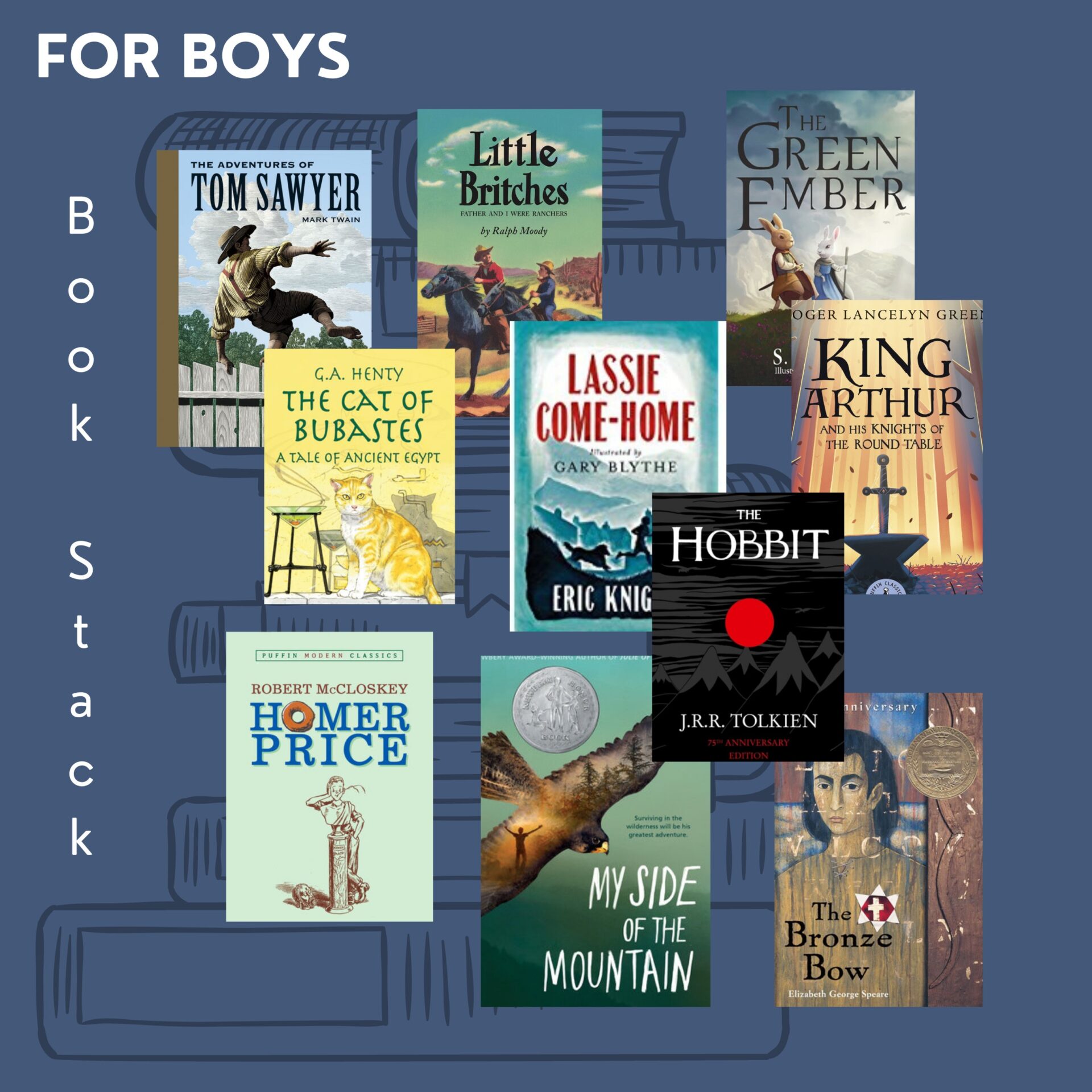
Send the boys in your life on an adventure with these books. Visit a graveyard with Tom Sawyer, battle wolves in The Green Ember, or run away to Catskill Mountains in My Side of the Mountain. If you have a reluctant reader then head off on the adventure with him and try a read-aloud. Get caught up in the emotions of Lassie Come-Home, travel back in time to Egypt in The Cat of Bubastes, or maybe you want to spend some time in the fantasy land of Middle Earth in The Hobbit. What’s left? King Arthur, Little Britches, The Bronze Bow, Homer Price. You could order a few copies of the same book and try a book club. by Adrianne Curwen Adrianne is a wife to a public-school educator/administrator and a homeschooling Mama to seven children, ranging in age from 7 to 23. She believes that we have a unique opportunity as homeschoolers to design individualized education that suits giftings, interests, and passions. She and her husband have used a blend of registered homeschooling, enrolment with independent DL schools, and participation in public trade school programs to design individualized programs for their children. She is passionate about using as many read-alouds, picture books, novels, and conversations to educate her children but also gets excited by the amazing homeschool-designed curriculum that’s out there. Adrianne is thrilled by her new role as Communication Specialist for Classical Education Books and is grateful to have an opportunity to learn something new. She is grateful, every day, for her saviour, Jesus Christ, and has no greater joy than when she sees her most important missions field walk with Him.
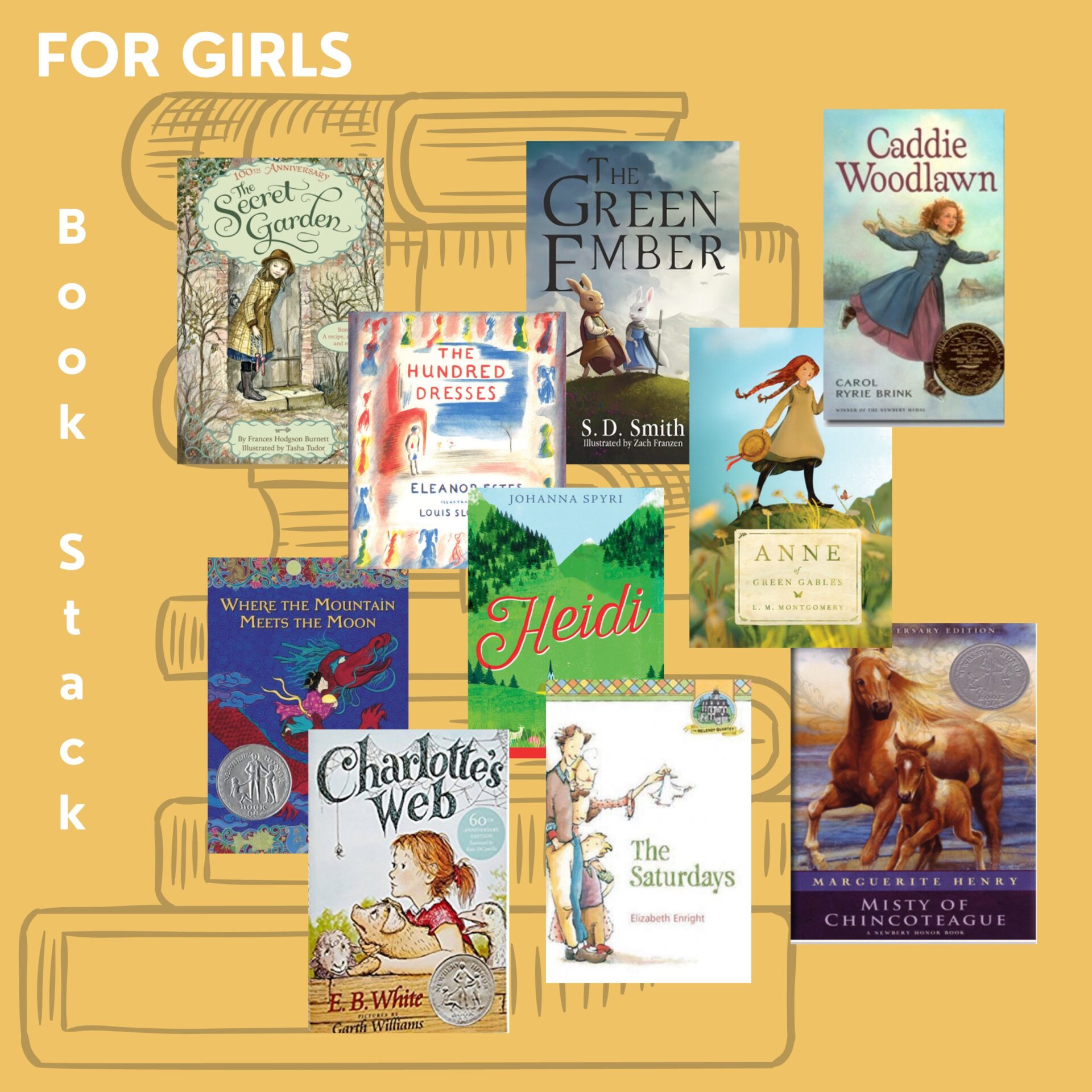
Books have much to offer our girls. These titles are packed with adventure, life lessons to explore, emotions to face, and new things to learn. Embark on a conversation about how we should treat others and the regret that follows when we don’t do the right thing, as you read The Hundred Dresses. Introduce your daughter to another culture in Where The Mountain Meets the Moon. And have fun with Caddie Woodlawn as you travel back to the 1860s. Is your girl all about horses? Then you need to get your hands on Misty of Chincoteague. I have a girl that was so intrigued by the fact that she kept forgetting Heather was a rabbit in The Green Ember. Meet the Melendy children in The Saturdays as they come up with a clever way of getting the most out of their Saturdays. Or how about planning a girl’s movie night? Don’t forget to read the book first. You have a few to choose from: The Secret Garden, Heidi, Anne of Green Gables, and Charlotte’s Web. by Adrianne Curwen Adrianne is a wife to a public-school educator/administrator and a homeschooling Mama to seven children, ranging in age from 7 to 23. She believes that we have a unique opportunity as homeschoolers to design individualized education that suits giftings, interests, and passions. She and her husband have used a blend of registered homeschooling, enrolment with independent DL schools, and participation in public trade school programs to design individualized programs for their children. She is passionate about using as many read-alouds, picture books, novels, and conversations to educate her children but also gets excited by the amazing homeschool-designed curriculum that’s out there. Adrianne is thrilled by her new role as Communication Specialist for Classical Education Books and is grateful to have an opportunity to learn something new. She is grateful, every day, for her saviour, Jesus Christ, and has no greater joy than when she sees her most important missions field walk with Him.
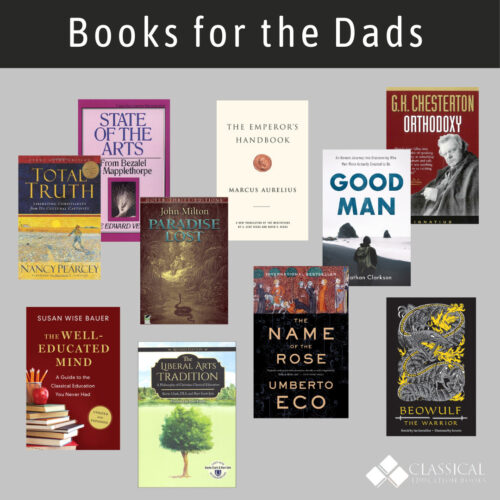
Many fathers are out of the house, working during the day, leaving the Moms to do the lion’s share of the homeschooling. It’s a setup that often makes sense but a father’s involvement is a blessing to his wife and children so we’ve selected a stack of books to help. There is something here for all dads. A few of these books will take you back to glean the timeless wisdom from writers who lived before you. Beowulf the Warrior is the retelling, in modern language, of a fictional classic, it would be a great one to start as a read aloud. The Emperor’s Handbook is a translation of Marcus Aurelius’ meditations. Major themes include character, leadership, and duty. You could explore the meaning of life in the 17th-century classic, Paradise Lost, or sink your teeth into G.K. Chesterton’s, Orthodoxy. Are you looking for something more specific to homeschooling? Try The Liberal Arts Tradition or The Well-Educated Mind. The Name of the Rose is part historical fiction, part mystery, and part theology; a fictional piece that challenges. If you are looking for something to fulfill the pragmatic side then try State of the Arts, Total Truth, or Good Man. Undecided? The links will take you to a full description of each title. by Adrianne Curwen Adrianne is a wife to a public-school educator/administrator and a homeschooling Mama to seven children, ranging in age from 7 to 23. She believes that we have a unique opportunity as homeschoolers to design individualized education that suits giftings, interests, and passions. She and her husband have used a blend of registered homeschooling, enrolment with independent DL schools, and participation in public trade school programs to design individualized programs for their children. She is passionate about using as many read-alouds, picture books, novels, and conversations to educate her children but also gets excited by the amazing homeschool-designed curriculum that’s out there. Adrianne is thrilled by her new role as Communication Specialist for Classical Education Books and is grateful to have an opportunity to learn something new. She is grateful, every day, for her saviour, Jesus Christ, and has no greater joy than when she sees her most important missions field walk with Him.



